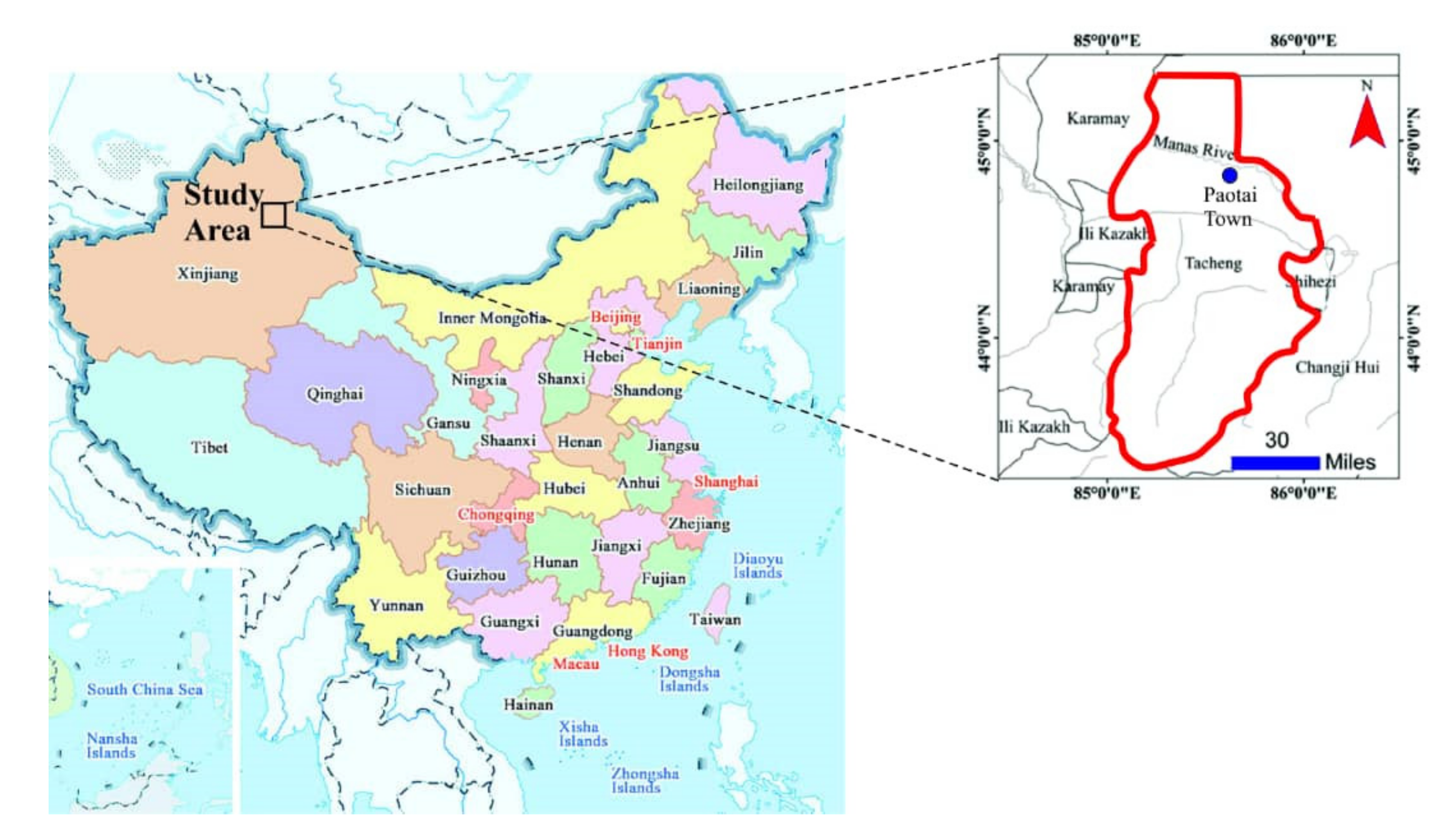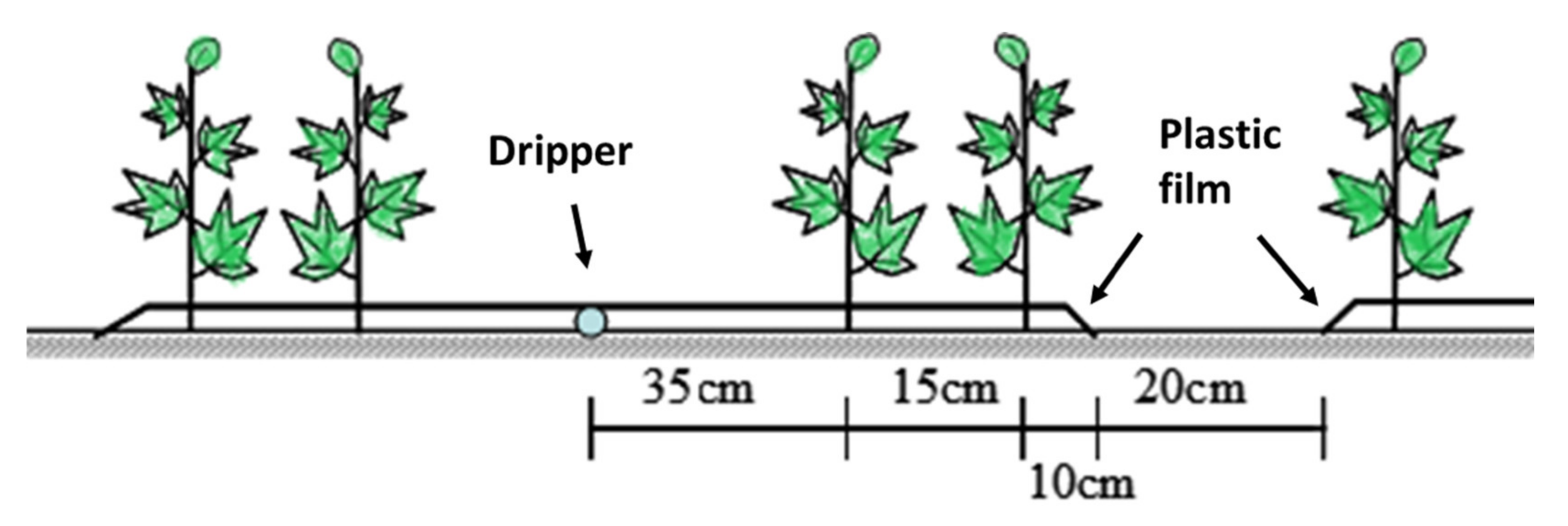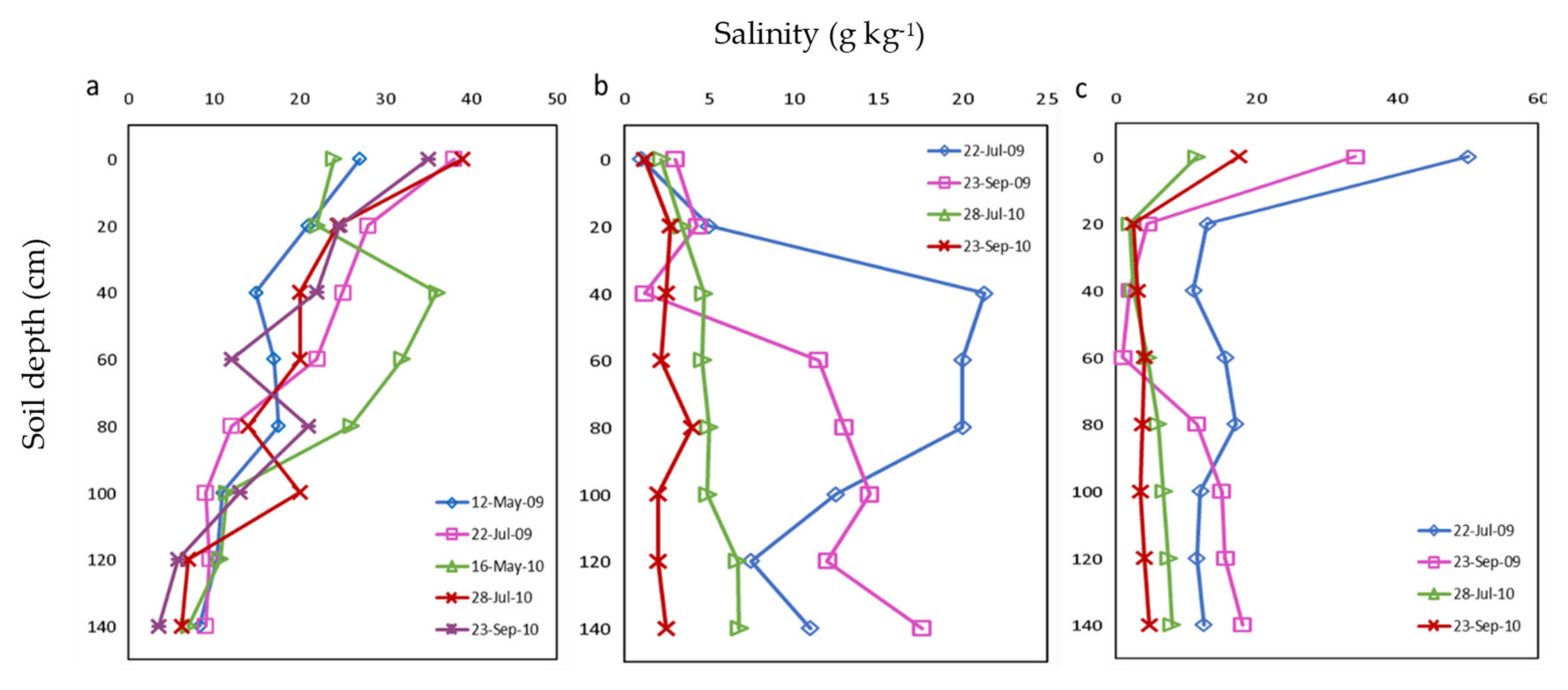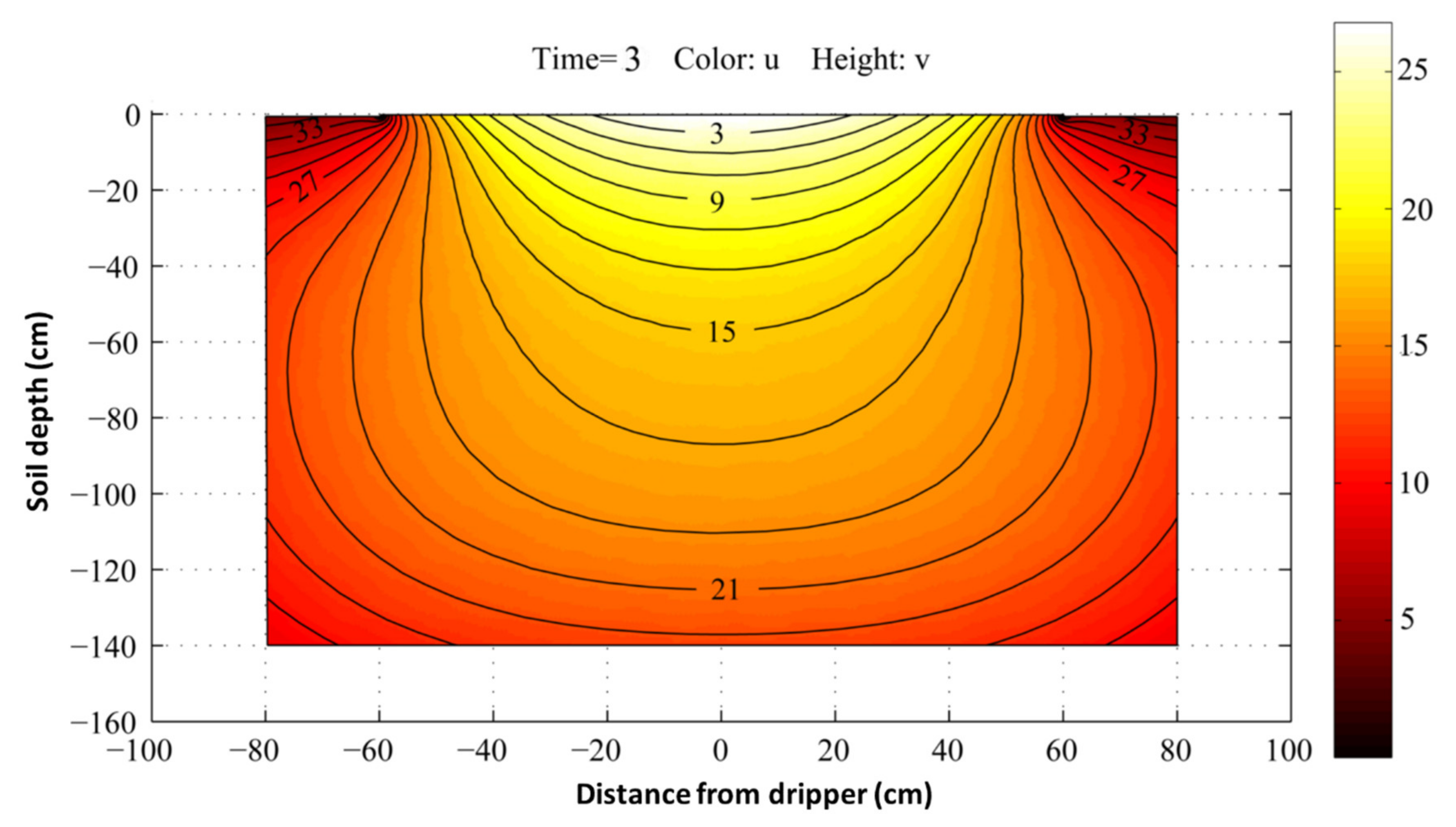Surface Salinization of Soil under Mulched Drip Irrigation
Abstract
:1. Introduction
2. Materials and Methods
2.1. Description of Experimental Field
2.2. Soil Sampling
2.3. Migration Simulation of Soil Salt of Bare Area in Condition of Outside-Mulch Evaporation
2.3.1. Basic Equation
2.3.2. Boundary Conditions
2.3.3. Soil Moisture Characteristics
2.3.4. Hydrodynamic Parameters of Soil
2.4. Numerical Model Calibration and Verification
3. Results
3.1. Changes in Salt Distribution by Drip Irrigation in Naturally Saline Soil
3.2. Long-Term Changes in Soil Salt Distribution by Drip Irrigation under Mulching
3.3. Coupling Simulation of Soil Salt and Water
4. Discussion
4.1. Increase in Surface Salinity on Bare Land Outside Mulch Is Due to the Salt Redistribution
4.2. Aggregation of Surface Salinity Only Occurs in Small Bare Land Area
4.3. Secondary Salinization under Drip Irrigation
5. Conclusions
Author Contributions
Funding
Conflicts of Interest
References
- Wang, Z.; Jin, M.; Šimůnek, J.; Van Genuchten, M.T. Evaluation of mulched drip irrigation for cotton in arid Northwest China. Irrig. Sci. 2013, 32, 15–27. [Google Scholar] [CrossRef] [Green Version]
- Li, M.; Liu, H.; Zheng, X. Spatiotemporal variation for soil salinity of field land under long-term mulched drip irrigation. Trans. Chin. Soc. Agric. Eng. 2012, 28, 82–87. [Google Scholar]
- Guan, Z.; Jia, Z.; Zhao, Z.; You, Q. Dynamics and Distribution of Soil Salinity under Long-Term Mulched Drip Irrigation in an Arid Area of Northwestern China. Water 2019, 11, 1225. [Google Scholar] [CrossRef] [Green Version]
- Mmolawa, K.; Or, D. Water and Solute Dynamics Under a Drip-Irrigated Crop: Experiments and Analytical Model. Trans. ASAE 2000, 43, 1597–1608. [Google Scholar] [CrossRef]
- Wang, H.; Wang, K.; Hou, Z.; Xin, L. Effects on cotton growth and salinity changes in different soil depth of drip irrigation in cotton field. Ecol. Environ. Sci. 2010, 19, 2381–2385, (In Chinese with English abstract). [Google Scholar]
- Zhang, W.; Lu, X.; Li, L.; Liu, J.; Sun, Z.; Zhang, X.; Yang, Y. Salt transfer law for cotton field with drip irrigation under the plastic mulch in Xinjiang Region. Trans. CSAE 2008, 24, 15–19, (In Chinese with English abstract). [Google Scholar]
- Yang, H.; Chen, Y.; Zhang, F. Evaluation of comprehensive improvement for mild and moderate soil salinization in arid zone. PLoS ONE 2019, 14, e0224790. [Google Scholar] [CrossRef] [PubMed]
- Wang, Z.; Fan, B.; Guo, L. Soil salinization after long-term mulched drip irrigation poses a potential risk to agricultural sustainability. Eur. J. Soil Sci. 2018, 70, 20–24. [Google Scholar] [CrossRef] [Green Version]
- Sakadevan, K.; Nguyen, M.-L. Extent, Impact, and Response to Soil and Water Salinity in Arid and Semiarid Regions. In Advances in Agronomy; Elsevier BV: Amsterdam, The Netherlands, 2010; Volume 109, pp. 55–74. [Google Scholar]
- Wang, F.; Chen, X.; Luo, G.; Han, Q. Mapping of regional soil salinities in Xinjiang and strategies for amelioration and management. Chin. Geogr. Sci. 2014, 25, 321–336. [Google Scholar] [CrossRef]
- Wang, S.L.; Zhou, H.P.; Qu, X.Y.; Guan, X.Y. Study on directional salt transport and surface salt draining under mulched drip irrigation in arid areas. J. Hydr. Eng. 2013, 44, 549–555. [Google Scholar]
- Tian, F.; Ni, G.; Hu, H. Experimental study on soil water-salt movement and irrigation scheduling for cotton under mulched drip irrigation condition. J. Hydr. Eng. 2010, 12, 1483–1490, (In Chinese with English abstract). [Google Scholar]
- Hassan, G.; Persaud, N.; Reneau, R.B. Utility of Hydrus-2d in Modeling Profile Soil Moisture and Salinity Dynamics Under Saline Water Irrigation of Soybean. Soil Sci. 2005, 170, 28–37. [Google Scholar] [CrossRef]
- Lei, Z.; Yang, S.; Xie, S. Soil Water Dynamics; Tsinghua University Press: Beijing, China, 1988; pp. 77–80. [Google Scholar]
- Li, Y.; Pang, H.; Zhang, H.; Chen, F.L. Effect of irrigation management on soil salinization in Manas River Valley, Xinjiang, China. Front. Agric. China 2008, 2, 216–223. [Google Scholar] [CrossRef]
- Zhang, Q.; Li, G.; Chai, F. Effect of mulched drip irrigation frequency on soil salt regime and cotton growth. J. Hydr. Eng. 2004, 9, 123–126, (In Chinese with English abstract). [Google Scholar]
- Tan, J.; Kang, Y.; Jiao, Y.; Liu, W.; Dong, F. Effects of cropping years on soil salinity and pH value in fields under drip irrigation condition. Trans. CSAE 2009, 25, 43–47, (In Chinese with English abstract). [Google Scholar]
- Sun, J.; Kang, Y.; Wan, S.; Hu, W.; Jiang, S.; Zhang, T. Soil salinity management with drip irrigation and its effects on soil hydraulic properties in north China coastal saline soils. Agric. Water Manag. 2012, 115, 10–19. [Google Scholar] [CrossRef]
- Wang, R.; Kang, Y.; Wan, S.; Hu, W.; Liu, S.; Jiang, S.; Liu, S. Influence of different amounts of irrigation water on salt leaching and cotton growth under drip irrigation in an arid and saline area. Agric. Water Manag. 2012, 110, 109–117. [Google Scholar] [CrossRef]
- Wang, Y.Q.; Liu, H.G.; Zhu, Y.J. Salinity Migration Rule under Mulching Plastic Drip Irrigation in Heavy Salty Soil. J. Irr. Drainag. 2010, 29, 58–60. [Google Scholar]
- Richards, L.A. Capillary Conduction of Liquids Through Porous Mediums. Physics 1931, 1, 318–333. [Google Scholar] [CrossRef]
- Van Genuchten, M.T. A Closed-form Equation for Predicting the Hydraulic Conductivity of Unsaturated Soils. Soil Sci. Soc. Am. J. 1980, 44, 892–898. [Google Scholar] [CrossRef] [Green Version]
- Liu, M.; Yang, J.-S.; Li, X.; Liu, G.; Yu, M.; Wang, J. Distribution and dynamics of soil water and salt under different drip irrigation regimes in northwest China. Irrig. Sci. 2012, 31, 675–688. [Google Scholar] [CrossRef]
- Wang, R.; Kang, Y.; Wan, S.; Hu, W.; Liu, S. Effect of Soil Matric Potential on Poplar Growth and Distribution of Soil Salt under Drip Irrigation in Saline-sodic Soil in Arid Regions. J. Irrig. Drain. 2013, 31, 1–6. [Google Scholar]
- Mai, W.; Tian, C.; Li, C. Soil Salinity Dynamics under Drip Irrigation and Mulch Film and Their Effects on Cotton Root Length. Commun. Soil Sci. Plant Anal. 2013, 44, 1489–1502. [Google Scholar] [CrossRef]
- Liu, X.; Tian, C. Study on Dynamic and Balance of Salt for Cotton under Plastic Mulch in South Xinjiang. J. Soil Water Conserv. 2005, 19, 82–84, (In Chinese with English abstract). [Google Scholar]
- Hou, Z.; Wang, Y.; Gong, J.; Xiao, L.; Ma, L.; Qi, T. Salt Distribution and Accumulation as Affected by Under- film Drip Irrigation with Saline Water in an Arid Region. Chin. J. Soil Sci. 2008, 1, 16–24, (In Chinese with English abstract). [Google Scholar]
- Danierhan, S.; Shalamu, A.; Tumaerbai, H.; Guan, D. Effects of emitter discharge rates on soil salinity distribution and cotton (Gossypium hirsutum L.) yield under drip irrigation with plastic mulch in an arid region of Northwest China. J. Arid. Land 2012, 5, 51–59. [Google Scholar] [CrossRef] [Green Version]




| Year | April | May | June | July | August | September |
|---|---|---|---|---|---|---|
| 2009 | 3.40 | 3.40 | 3.40 | 3.40 | 3.40 | 3.40 |
| 2010 | 3.40 | 3.40 | 3.64 | 3.60 | 3.43 | 3.57 |
| Date | 2 May | 17 May | 30 May | 10 June | 20 June | 1 July | 12 July | 22 July | 4 August | 25 August |
|---|---|---|---|---|---|---|---|---|---|---|
| Irrigation amount (m3 ha−1) | 525 | 450 | 450 | 450 | 525 | 525 | 525 | 525 | 525 | 450 |
| Sampling Area | Soil Layer Depth (cm) | Sampling Date | |||
|---|---|---|---|---|---|
| 16 May 2010 | 3 July 2010 | 28 July 2010 | 23 September 2010 | ||
| Mulching | 0 | 2.28 | 0.88 | 0.52 | 0.55 |
| 10 | 2.32 | 0.94 | 0.53 | 0.57 | |
| 20 | 2.24 | 0.84 | 0.53 | 0.74 | |
| 30 | 2.53 | 1.18 | 0.55 | 0.55 | |
| 40 | 2.52 | 1.17 | 0.62 | 0.61 | |
| Bare soil | 0 | 5.27 | 4.41 | 2.08 | 3.40 |
| 10 | 3.32 | 2.11 | 0.87 | 0.97 | |
| 20 | 2.50 | 1.14 | 0.98 | 0.84 | |
| 30 | 2.72 | 1.41 | 0.97 | 0.47 | |
| 40 | 2.63 | 1.30 | 1.07 | 0.60 | |
| Bare Soil | Mulching |
|---|---|
| 0.4743 | 0.5051 |
| Bare Soil | Mulching |
|---|---|
| 0.9507 | 0.9579 |
Publisher’s Note: MDPI stays neutral with regard to jurisdictional claims in published maps and institutional affiliations. |
© 2020 by the authors. Licensee MDPI, Basel, Switzerland. This article is an open access article distributed under the terms and conditions of the Creative Commons Attribution (CC BY) license (http://creativecommons.org/licenses/by/4.0/).
Share and Cite
Liu, H.; Li, M.; Zheng, X.; Wang, Y.; Anwar, S. Surface Salinization of Soil under Mulched Drip Irrigation. Water 2020, 12, 3031. https://doi.org/10.3390/w12113031
Liu H, Li M, Zheng X, Wang Y, Anwar S. Surface Salinization of Soil under Mulched Drip Irrigation. Water. 2020; 12(11):3031. https://doi.org/10.3390/w12113031
Chicago/Turabian StyleLiu, Hongguang, Mingsi Li, Xurong Zheng, Yaqin Wang, and Sumera Anwar. 2020. "Surface Salinization of Soil under Mulched Drip Irrigation" Water 12, no. 11: 3031. https://doi.org/10.3390/w12113031
APA StyleLiu, H., Li, M., Zheng, X., Wang, Y., & Anwar, S. (2020). Surface Salinization of Soil under Mulched Drip Irrigation. Water, 12(11), 3031. https://doi.org/10.3390/w12113031






